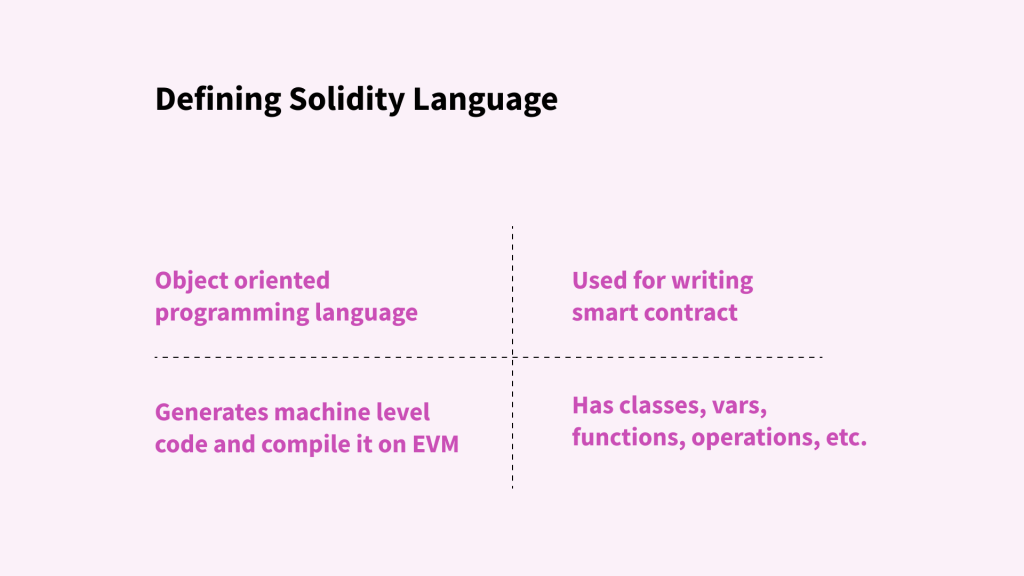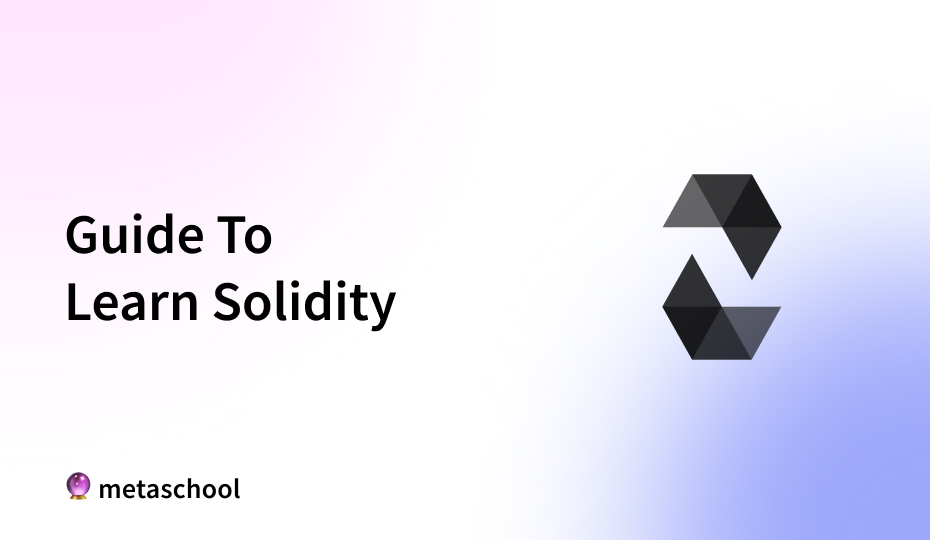Table of Contents
Solidity is an object-oriented, high-level programming language specifically developed for writing smart contracts and EVM-compatible code. It is one of the most popular smart contract languages which lets developers develop on Ethereum and other EVM-compatible blockchains. Learning solidity is considered to be one of the first stepping stone to get into the world of Web3 and Blockchain development.

In this blog, we’ll talk about the fastest ways for you to learn Solidity programming language. We’ve also introduced important Solidity concepts that for you to learn and get a head start for writing solidity contracts in Ethereum.
Why is learning Solidity important?
As of 2024, with Ethereum powering over 4,000 dApps, 53+ million smart contracts, and 96+ million accounts, learning Solidity has become more crucial than ever for developers looking to enter the blockchain space.
Learning Solidity opens doors to a rapidly growing ecosystem and lucrative career opportunities. As the primary language for Ethereum smart contracts, Solidity is instrumental in developing decentralized applications (dApps) across various domains, including DeFi, NFTs, and DAOs. Its versatility and the high demand for skilled developers make it a valuable skill in the job market. Moreover, Solidity’s compatibility with multiple EVM-compatible blockchains extends its applicability beyond Ethereum, allowing developers to create interoperable solutions. By mastering Solidity, developers position themselves at the forefront of blockchain innovation, enabling them to create new business models and drive technological advancements in this transformative field.
Solidity is Pivotal in the Growth of dApps
Solidity powers the development of decentralized apps on Ethereum and other EVM-compatible blockchains. These applications leverage blockchain’s decentralized nature to provide services that are transparent, secure, and resistant to censorship.
Use Cases:
- DeFi (Decentralized Finance): Platforms like Uniswap and Aave enable decentralized trading and lending, revolutionizing traditional finance.
- NFTs (Non-Fungible Tokens): Solidity is used to create and manage NFTs, enabling digital ownership of art, collectibles, and more.
- DAOs (Decentralized Autonomous Organizations): These organizations run on smart contracts, facilitating decentralized governance and decision-making.
Essential for Blockchain Innovation
Solidity plays a crucial role in driving innovation within the blockchain industry. By enabling developers to create complex smart contracts and dApps, Solidity facilitates new use cases and business models that were previously impossible.
Use Cases:
- Tokenization: Solidity allows for the creation of various types of tokens (e.g., ERC20, ERC721), enabling new economic models and asset digitization.
- Supply Chain: Smart contracts can automate and verify supply chain processes, enhancing efficiency and transparency.
- Identity Management: Blockchain-based identity systems can offer secure and verifiable digital identities.
Interoperability with Other EVM-Compatible Blockchains
Solidity’s compatibility with the Ethereum Virtual Machine (EVM) means that it can be used on multiple blockchains that support EVM, such as Binance Smart Chain (BNB), Polygon, and Avalanche. This interoperability expands the potential applications and reach of Solidity-based projects.
Advantages:
- Cross-Chain Development: Developers can create applications that interact with multiple blockchains, enhancing functionality and user reach.
- Resource Sharing: Tools and libraries developed for Solidity on Ethereum can often be used on other EVM-compatible chains, streamlining development.
Solidity Developer Salaries
The rapid expansion of the blockchain ecosystem has led to a high demand for Solidity developers. Companies and projects in the blockchain space are constantly seeking solidity developers to build and maintain their smart contracts and dApps.
A Senior Solidity Developer can earn between $120,000 to $225,000 annually, excluding token-based equity or ESOPs. According to cryptocurrencyjobs.co, the average salary for Solidity developers in the USA is $127,500, with remote developers earning between $111,000 and $200,000 annually. Comparatively, the average salary for US-based developers is $103,000, highlighting the demand for Solidity and blockchain specialization in developers.
Here is a list of location-based salaries of Solidity developers per year (in USD):
- North America: $125K – $200K
- Europe: $80K – $135K
- Asia: $46K – $116K
- Oceania: $85K – $120K
- South America: $49K – $150K
- Africa: $49K – $75K
- Remote: $111K – $200K
Beyond financial benefits, learning Solidity enables developers to create impactful dApps. Ethereum alone hosts nearly 4,000 dApps addressing various needs, from Decentralised financial to solving for digital asset ownership.
How to Learn Solidity Programming Language
Learning Solidity involves understanding both the language itself and the underlying blockchain concepts. There are many ways to approach Solidity language, here we’ll discuss the fastest ways to learn solidity and then various other methods including online courses, guided projects, video tutorials, and reading documentation from official website.
1. Learn Solidity on Metaschool
Metaschool offer intensive, hands-on training in a structured web3 learning program. Metaschool’s hands-on Ethereum development courses are offered for free. These self-paced and structured courses guide you to write Smart Contracts in Solidity, build NFTs, and teach you to create your own Ethereum Token in 30 mins with expert instruction and a guided learning environment.
Developers at every stage of their learning journey will benefit from Metaschool’s Solidity learning tracks and learn to build real-world applications quickly.

2. Learn Solidity With Online Courses
Online courses provide structured learning with set lessons and deadlines, which can help learners stay motivated. Alchemy University’s free Solidity Development Course is an excellent option for those seeking guided instruction. These courses often include quizzes and assignments to test your knowledge.
3. Learn Solidity From Tutorials
For self-starters, tutorials offer flexible, self-paced learning. The official Ethereum developer resources feature 53 tutorials covering a range of topics from basic smart contracts to advanced subjects like gas optimization and secure signing.
4. Learn Solidity from Documentation
Soliditylang is the official website where you can find the documentation, user cases, and all details on versions of Solidity. This is a great resource and an ideal place to start for experienced developers who understand JavaScript and can pick up new concepts and language from documentation.
You will also find a list of Solidity use cases if you are wondering why you need a to learn a new language to write smart contracts and to build decentralised apps on Ethereum and other blockchains.
Learn Solidity Concepts
Understanding these key concepts is crucial for becoming proficient in Solidity development:
- Smart Contracts: Self-executing contracts with the terms directly written into code. They are the foundation of dApps and form the core of Solidity programming.
- Solidity ABI (Application Binary Interface): Allows different pieces of software to interact. In Solidity, the ABI enables smart contracts to communicate with each other and with external software, like wallets.
- ERC20 Tokens: A common type of digital asset on Ethereum, representing fungible tokens. Creating ERC20 tokens is an essential skill for Solidity developers.
- Contract Interfaces: Specify the functions a contract must have, promoting reusable and extendable code. They define a contract’s external-facing functionality.
- Inheritance: Allows developers to create child contracts that inherit code from parent contracts, reducing redundancy and simplifying maintenance.
- Functions and Function Visibility: Functions perform actions based on inputs and return outputs. Visibility settings (public, external, internal, or private) determine who can execute a function.
- Call and Delegatecall Functions:
call: Executes code in another contract.delegatecall: Executes code in the context of the caller, allowing storage changes to affect the caller’s storage.
- Modifiers: Alter the behavior of functions without modifying their code. They are used to enforce rules, such as requiring a user to have a certain balance.
- Arrays and Structs:
- Arrays: Store elements of the same data type.
- Structs: Allow for more complex data types with multiple properties.
- Mappings: Versatile data structures that store data in key-value pairs, providing flexible storage solutions.
- Events: Trigger code execution in response to specific conditions, enabling dApps to interact with the real world and facilitating logging.
- Error Handling:
require(): Checks conditions and reverts transactions if conditions are not met.assert(): Used to check for internal errors and invariants.revert(): Aborts execution and reverts state changes.
- Upgradeable Smart Contracts: Contracts that can be updated without redeployment, maintaining existing data and code on the blockchain.
- Proxy Contracts: Route function calls to the latest implementation, allowing protocols to upgrade without requiring users to update their code.
- Multisig Contracts: Require multiple signatures to execute, adding security for high-value transactions.
- Reentrancy Attacks: These attacks exploit vulnerabilities in contracts by calling back into a contract before execution is complete. Understanding reentrancy is crucial for writing secure contracts.
- Gas Optimization: Techniques to minimize the computational cost of contract execution, crucial for efficient and cost-effective smart contracts.
- Memory vs. Storage: Understanding the difference between temporary (memory) and persistent (storage) data storage in Solidity.
- Fallback and Receive Functions: Special functions that handle incoming Ether transactions and calls to undefined functions.
- Libraries: Reusable pieces of code that can be called from other contracts, promoting code reuse and gas efficiency.
Mastering these concepts will provide a solid foundation for Solidity development. As you progress through your learning journey, focus on understanding and applying these concepts in practical projects.
The Fastest Way to Learn Solidity
There are many paths to learning Solidity, whether through tutorials, online courses, or bootcamps. Mastering core concepts like smart contracts, functions, and events is essential. With dedication and the right resources, you can become a proficient Solidity developer and unlock numerous opportunities in the blockchain space.
The best way to learn solidity is by building hands-on projects and following guided courses. Here are a few popular courses on Metaschool that you can start with:
- Write Your First Solidity Smart Contract on Ethereum (Beginner)
- Create Your Own Ethereum Token in Just 30 Mins (Beginner)
- Write an Elon Musk NFT Smart Contract on OpenSea (Intermediate)
- Build a One Piece Personality dApp With Solidity (Advanced)
FAQs
Is Solidity easy to learn?
Solidity can be easy to learn for those with a programming background and some understanding of blockchain concepts. For beginners, the learning curve may be steeper, but with the right resources and support, it is certainly manageable. Engaging with the developer community, utilizing high-quality courses, and starting with foundational programming and blockchain concepts can greatly enhance the learning experience.
Can I learn Solidity from scratch?
Yes, you can learn Solidity from scratch, even if you have no prior programming experience. Here’s a step-by-step guide to help you get started:
1. Start with JavaScript
2. Learn Blockchain Fundamentals
3. Learn Ethereum basics
4. Start learning solidity with online free resources like Metaschool.
5. Write simple smart contracts, create NFTs/Token, and create your own project. You can find hands-on guided projects on Metaschool as well.
Learning Solidity from scratch is entirely possible with dedication and the right resources. Start with basic programming and blockchain concepts, then dive into Solidity with structured courses and hands-on practice. Engage with the developer community, stay updated with the latest trends, and continuously build and improve your skills. By following this structured approach, you’ll be well on your way to becoming a proficient Solidity developer.
How much time does it take to learn Solidity?
The time required to learn Solidity can range from a few months for experienced programmers to about 6-9 months for complete beginners. By dedicating consistent time each day or week and using a combination of structured courses, tutorials, and hands-on projects, you can efficiently learn Solidity and become proficient in developing smart contracts and dApps on Ethereum.
Should I learn Solidity or Python?
The choice between learning Solidity or Python depends on your career goals, interests, and the type of projects you want to work on. Solidity is essential for developing smart contracts and dApps on Ethereum and other EVM-compatible blockchains. On the other hand, Python is a general-purpose language used in various fields, including web development, data science, machine learning, automation, and more.
You want to focus on blockchain development and contribute to the Web3 ecosystem, you should learn Solidity to write smart contracts and build dApps.
